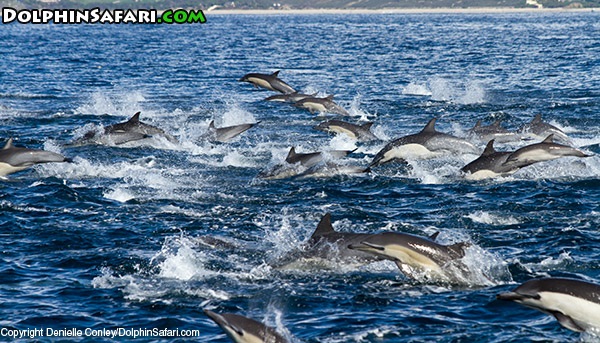Interactions
Common dolphins are found in almost every ocean
in the world. With that
being said, there are many ways these dolphins forage for their
food.
Delphinus
delphis live and hunt for food in herds of either a few tens or up
to several hundred dolphins.
The common dolphin can go to depths of up to 260 meters, but
most dives are less than 100 meters (Pusineri, 2007).
Not much is known about the diet in the oceanic habitats, but
more is known about the neritic areas.
In the neritic areas, the common dolphin is the top predator
on the food chain. They
have three main food groups; the small schooling fish (sardines and
anchovies), the fish from deeper layers (sea smelt and lanternfish),
and
cephalopods which are squids (Neumann, 2001) and (Nino –Torres
2006). These predators will hunt day and night for different foods.
During the day, the squids are at a deeper depth, so the
common dolphins will feed on the sardine, anchovy, horse mackerel,
and
cod. During the
night, the dolphins will dive deep and catch the squid.
About 85% of the diet of the common dolphin is comprised of
fish. The diet in
oceanic habitats is completely different than the neritic areas
(Pusineri, 2007). In the
oceanic areas, the dolphins rely on mesopelagic organisms to migrate
to the surface at night.
Scientists found consistency of lantern fish being in the stomachs
of common dolphins.
Dolphins will only forage in oceanic or neritic habitats, but not
both. 
Even though there is a lot of information on what common
dolphins feed on, not much is known about how the fish are caught.
There is a high variability in feeding strategies.
It all depends on the habitat, desired prey, and the
knowledge of different techniques that allows for the use of certain
methods (Neumann, 2001).
The most documented method of common dolphins catching prey
is when they round up small schooling fish and drive them to the
surface where the then cut through the center and eat their prey.
This type of foraging often attracts other organisms to get
in on the action. Some
of these organisms are other dolphins and diving birds.
Figure 2. Above and underwater video taken by Captain Dave Anderson of a pod of common dolphins. http://www.dolphinsafari.com/
(To look at the complete article that this video is on go to this National Geographic link.)
Common dolphins have been observed having interactions with
other dolphins. There
have been multiple observations of common dolphins interacting with
striped dolphins (Stenella coeruleoalba) and Risso’s dolphin
(Grampus griseus). About
25% of all common dolphin sightings in the Mediterranean Sea were
with other dolphin species.
There have been herd of up to 200 striped dolphins and 80
common dolphins together (Frantzis, 2002).
Off the coast of California, common dolphins are regularly
sighted with sea lions.
The sea lions would skyhop and adjust their route to find dolphin
pods. Common dolphins and sea lions were observed feeding together
at the same time. There
was no aggression between them.
The dolphins and sea lions would adapt each other’s
techniques for finding prey (Berzi, 2006).
Common dolphins and humans have had a history of interacting
with each other. Dolphin
tourism has been a big part of informing people about a need for
nature conservation.
Some people think that it is bad for the dolphins.
They say that the noises of the engines increase the depth
time of dolphins. It
also changes behavior, eating habits, and disrupting resting
activities. Some common
dolphins are hunted off the coast of Peru and in the Black sea.
Shark nets that keep sharks away from swimmers pose a problem
to the common dolphin.
They are also caught as by catch in the nets of fishing boats.
In one year alone, 15,000 common dolphins were caught in the
nets of tuna fisheries (Neumann, 2001).
